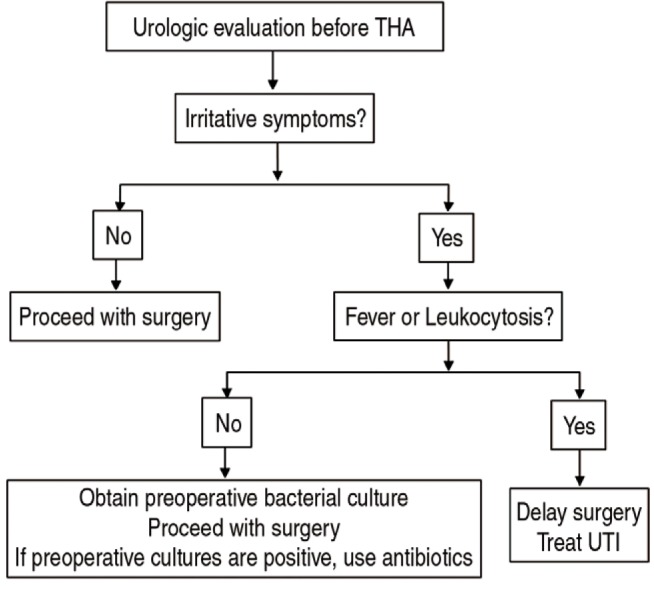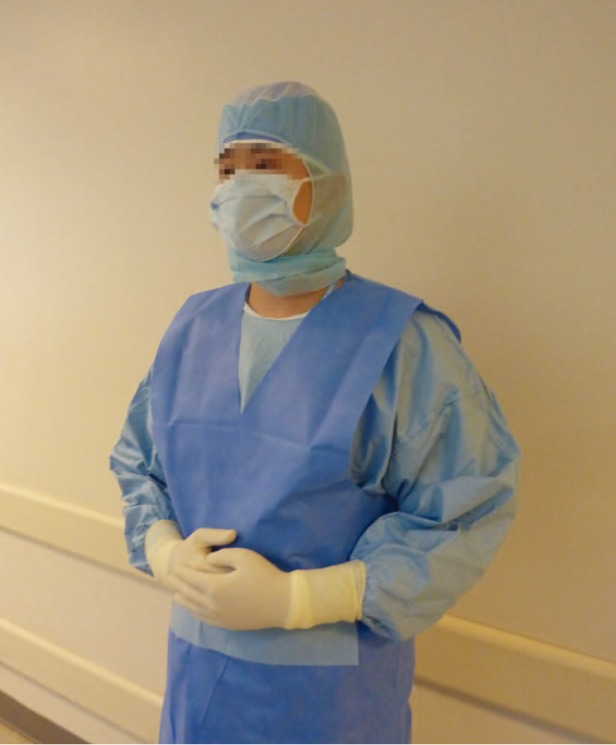Hip Pelvis.
2017 Mar;29(1):30-34. 10.5371/hp.2017.29.1.30.
Lower Urinary Tract Infection and Periprosthetic Joint Infection after Elective Primary Total Hip Arthroplasty
- Affiliations
-
- 1Department of Orthopaedic Surgery, Yeungnam University Medical Center, Daegu, Korea.
- 2Department of Orthopaedic Surgery, Seoul National University Bundang Hospital, Seongnam, Korea. khkoo@snu.ac.kr
- KMID: 2371765
- DOI: http://doi.org/10.5371/hp.2017.29.1.30
Abstract
- PURPOSE
Periprosthetic joint infection (PJI) after total hip arthroplasty (THA) is a grave complication. Urinary tract infection (UTI) as a source for PJI is controversial. Our purposes were, (1) to evaluate the incidence of PJI after elective primary THA and (2) to determine whether UTI was associated with a risk of PJI after elective primary THA.
MATERIALS AND METHODS
We retrospectively reviewed the medical records of 527 patients who underwent elective primary THA by using universal aseptic technique from May 2003 to October 2007. UTI group (13 patients) was defined as patients who underwent THA in status of having an UTI, and the remaining patients were defined as control group (514 patients). We compared the incidence of PJI in both groups.
RESULTS
During the study period, the incidence of PJI was 0%, regardless of existence (or presence) of UTI.
CONCLUSION
There was no significant association between UTI and PJI, when cautiously performed THA.
MeSH Terms
Figure
Cited by 1 articles
-
Should a Urinary Tract Infection Be Treated before a Total Joint Arthroplasty?
Javad Parvizi, Kyung-Hoi Koo
Hip Pelvis. 2019;31(1):1-3. doi: 10.5371/hp.2019.31.1.1.
Reference
-
1. Springer BD, Fehring TK, Griffin WL, Odum SM, Masonis JL. Why revision total hip arthroplasty fails. Clin Orthop Relat Res. 2009; 467:166–173. PMID: 18975043.
Article2. Jafari SM, Coyle C, Mortazavi SM, Sharkey PF, Parvizi J. Revision hip arthroplasty: infection is the most common cause of failure. Clin Orthop Relat Res. 2010; 468:2046–2051. PMID: 20195808.
Article3. Urquhart DM, Hanna FS, Brennan SL, et al. Incidence and risk factors for deep surgical site infection after primary total hip arthroplasty: a systematic review. J Arthroplasty. 2010; 25:1216–1222. 1222.e1–1222.e3. PMID: 19879720.
Article4. Pulido L, Ghanem E, Joshi A, Purtill JJ, Parvizi J. Periprosthetic joint infection: the incidence, timing, and predisposing factors. Clin Orthop Relat Res. 2008; 466:1710–1715. PMID: 18421542.
Article5. Phillips CB, Barrett JA, Losina E, et al. Incidence rates of dislocation, pulmonary embolism, and deep infection during the first six months after elective total hip replacement. J Bone Joint Surg Am. 2003; 85-A:20–26. PMID: 12533567.
Article6. Kurtz SM, Lau E, Schmier J, Ong KL, Zhao K, Parvizi J. Infection burden for hip and knee arthroplasty in the United States. J Arthroplasty. 2008; 23:984–991. PMID: 18534466.
Article7. Blom AW, Taylor AH, Pattison G, Whitehouse S, Bannister GC. Infection after total hip arthroplasty. The Avon experience. J Bone Joint Surg Br. 2003; 85:956–959. PMID: 14516026.8. Bozic KJ, Ries MD. The impact of infection after total hip arthroplasty on hospital and surgeon resource utilization. J Bone Joint Surg Am. 2005; 87:1746–1751. PMID: 16085614.
Article9. Kurtz SM, Lau E, Watson H, Schmier JK, Parvizi J. Economic burden of periprosthetic joint infection in the United States. J Arthroplasty. 2012; 27(8 Suppl):61–65.e1. PMID: 22554729.
Article10. Fehring TK, Odum SM, Berend KR, et al. Failure of irrigation and débridement for early postoperative periprosthetic infection. Clin Orthop Relat Res. 2013; 471:250–257. PMID: 22552768.
Article11. Kalra KP, Lin KK, Bozic KJ, Ries MD. Repeat 2-stage revision for recurrent infection of total hip arthroplasty. J Arthroplasty. 2010; 25:880–884. PMID: 20206469.
Article12. Hamilton WG, McAuley JP. Sepsis: Etiology, prophylaxis, and diagnosis. In : Calaghan JJ, Rosenberg AG, Rubash HE, editors. The adult hip. 2nd ed. Philadelphia: Lippincott Williams & Wilkins;2007. p. 1257–1270. .13. Koulouvaris P, Sculco P, Finerty E, Sculco T, Sharrock NE. Relationship between perioperative urinary tract infection and deep infection after joint arthroplasty. Clin Orthop Relat Res. 2009; 467:1859–1867. PMID: 19009324.
Article14. David TS, Vrahas MS. Perioperative lower urinary tract infections and deep sepsis in patients undergoing total joint arthroplasty. J Am Acad Orthop Surg. 2000; 8:66–74. PMID: 10666654.
Article15. Blomgren G, Lindgren U. Late hematogenous infection in total joint replacement: studies of gentamicin and bone cement in the rabbit. Clin Orthop Relat Res. 1981; (155):244–248. PMID: 7226617.16. D'Ambrosia RD, Shoji H, Heater R. Secondarily infected total joint replacements by hematogenous spread. J Bone Joint Surg Am. 1976; 58:450–453. PMID: 1270463.17. Cruess RL, Bickel WS, vonKessler KL. Infections in total hips secondary to a primary source elsewhere. Clin Orthop Relat Res. 1975; (106):99–101.
Article18. Ainscow DA, Denham RA. The risk of haematogenous infection in total joint replacements. J Bone Joint Surg Br. 1984; 66:580–582. PMID: 6430907.
Article19. Glynn MK, Sheehan JM. The significance of asymptomatic bacteriuria in patients undergoing hip/knee arthroplasty. Clin Orthop Relat Res. 1984; (185):151–154. PMID: 6705373.
Article20. Kalra OP, Raizada A. Approach to a patient with urosepsis. J Glob Infect Dis. 2009; 1:57–63. PMID: 20300389.
Article21. Namba RS, Inacio MC, Paxton EW. Risk factors associated with surgical site infection in 30,491 primary total hip replacements. J Bone Joint Surg Br. 2012; 94:1330–1338. PMID: 23015556.
Article22. Jämsen E, Nevalainen P, Eskelinen A, Huotari K, Kalliovalkama J, Moilanen T. Obesity, diabetes, and preoperative hyperglycemia as predictors of periprosthetic joint infection: a single-center analysis of 7181 primary hip and knee replacements for osteoarthritis. J Bone Joint Surg Am. 2012; 94:e101. PMID: 22810408.23. Soohoo NF, Farng E, Lieberman JR, Chambers L, Zingmond DS. Factors that predict short-term complication rates after total hip arthroplasty. Clin Orthop Relat Res. 2010; 468:2363–2371. PMID: 20428982.
Article24. Roorda LD, Jones CA, Waltz M, et al. Satisfactory cross cultural equivalence of the Dutch WOMAC in patients with hip osteoarthritis waiting for arthroplasty. Ann Rheum Dis. 2004; 63:36–42. PMID: 14672889.
Article25. Fielden JM, Cumming JM, Horne JG, Devane PA, Slack A, Gallagher LM. Waiting for hip arthroplasty: economic costs and health outcomes. J Arthroplasty. 2005; 20:990–997. PMID: 16376253.26. Song KH, Kang YM, Sin HY, et al. Outcome of cefazolin prophylaxis for total knee arthroplasty at an institution with high prevalence of methicillin-resistant Staphylococcus aureus infection. Int J Infect Dis. 2011; 15:e867–e870. PMID: 22019197.
Article27. Parvizi J, Zmistowski B, Berbari EF, et al. New definition for periprosthetic joint infection: from the Workgroup of the Musculoskeletal Infection Society. Clin Orthop Relat Res. 2011; 469:2992–2994. PMID: 21938532.
Article28. Saleh K, Olson M, Resig S, et al. Predictors of wound infection in hip and knee joint replacement: results from a 20 year surveillance program. J Orthop Res. 2002; 20:506–515. PMID: 12038624.
Article29. Kang BJ, Lee YK, Kim HJ, Ha YC, Koo KH. Deep venous thrombosis and pulmonary embolism are uncommon in East Asian patients after total hip arthroplasty. Clin Orthop Relat Res. 2011; 469:3423–3428. PMID: 21748508.
Article30. Kim YH, Kim JS. The 2007 John Charnley Award. Factors leading to low prevalence of DVT and pulmonary embolism after THA: analysis of genetic and prothrombotic factors. Clin Orthop Relat Res. 2007; 465:33–39. PMID: 17693875.
- Full Text Links
- Actions
-
Cited
- CITED
-
- Close
- Share
- Similar articles
-
- Should a Urinary Tract Infection Be Treated before a Total Joint Arthroplasty?
- Treatment of Periprosthetic Tuberculous Infection of Total Hip Arthroplasty with Long Term Medication without Implant Removal
- Three Concurrent Periprosthetic Joint Infections: A Case Report and Literature Review
- Stenotrophomonas maltophilia Periprosthetic Joint Infection after Hip Revision Arthroplasty
- Economic Burden of Periprosthetic Joint Infection Following Primary Total Knee Replacement in a Developing Country



